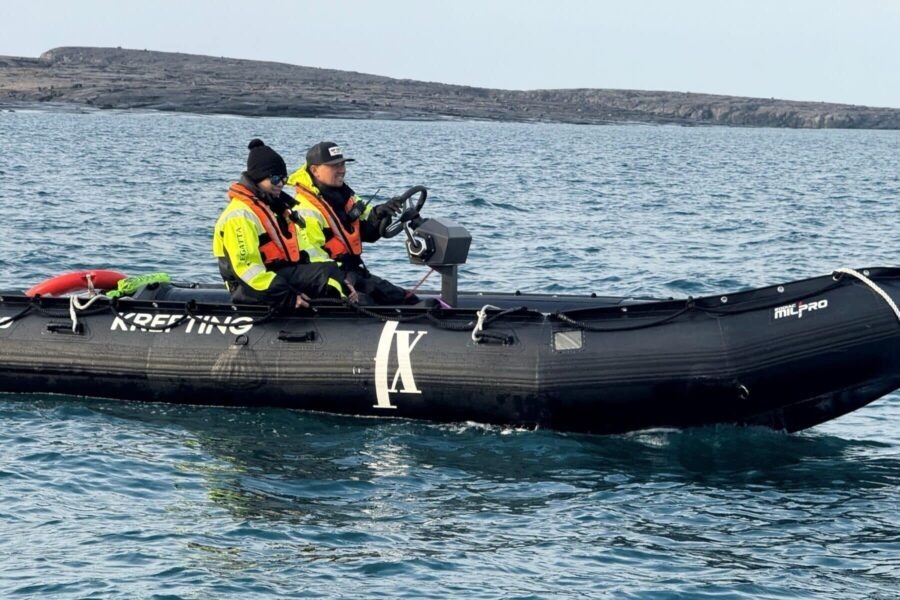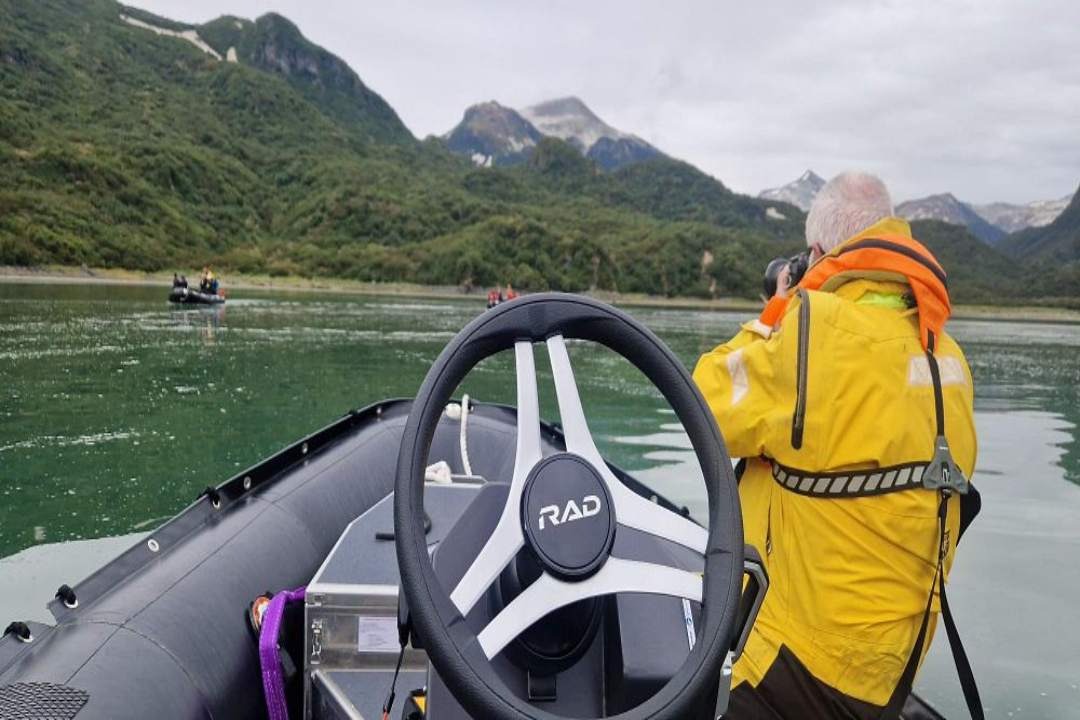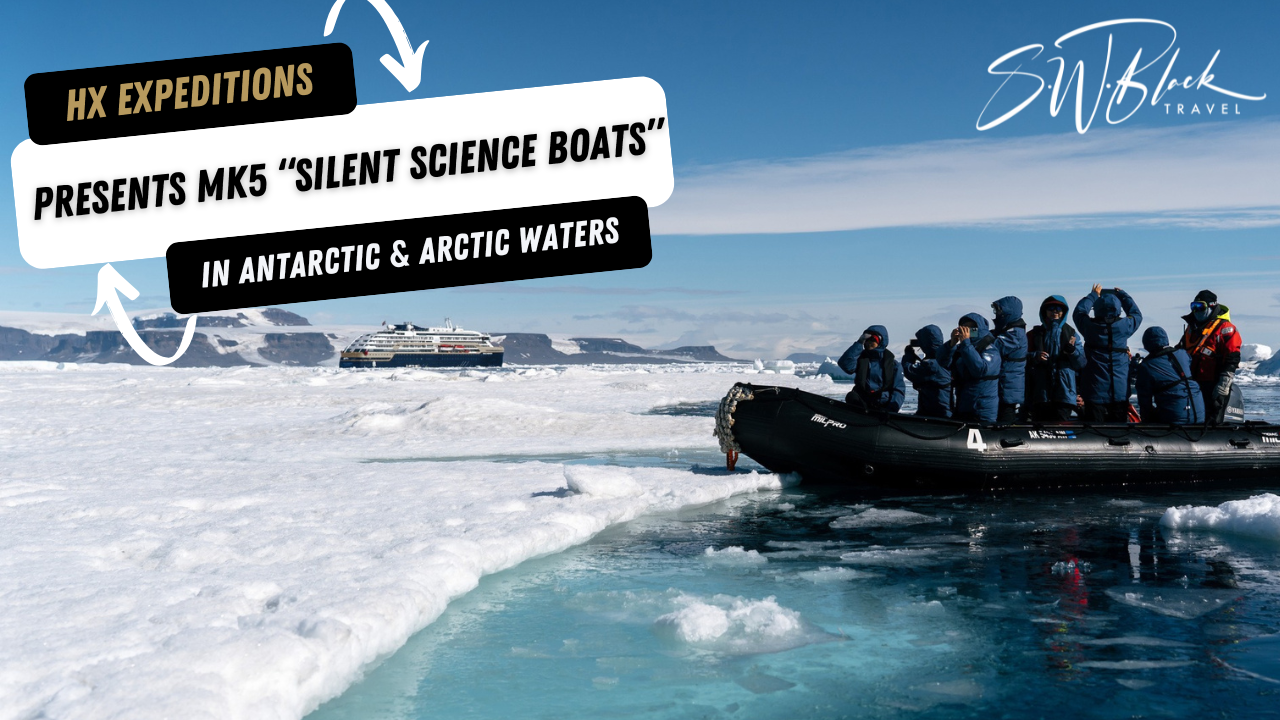There is something unforgettable about crossing a bay in Antarctica or the Arctic when the only sounds are the crackle of ice and the call of seabirds. HX Expeditions is leaning into that feeling with a new pair of fully electric boats that are purpose-built to cut underwater noise, support onboard science, and give guests a quieter, more considered way to explore some of the planet’s most fragile waters.
HX Expeditions has introduced fully electric MK5 silent science boats in the Antarctic and Arctic, using RAD Propulsion’s RAD 40 drive systems. These soft inflatable boats carry around 8 to 16 guests, are operated by trained drivers from MS Fram and MS Fridtjof Nansen, and are designed to reduce underwater noise, enhance research, and create calmer wildlife encounters.
Understanding HX’s Electric Polar Boat Innovation
To really appreciate what HX is doing here, it helps to zoom in on how these new boats differ from the standard inflatables most expedition travellers are used to. On first glance, they still look familiar, with their soft tubes and open layout, but almost everything beneath the surface has been redesigned around electricity, science support, and a quieter profile in the water.
For guests coming from Australia, Asia, Europe, or North America, this is a reassuring sign that expedition operators are now updating the smaller, everyday parts of the experience, not just the main ship engines and marketing language.
Why Underwater Noise Matters in the Polar Regions
In the icy waters of Antarctica and the Arctic, sound travels an extraordinary distance. Whales, seals, and many fish species rely on sound to navigate, find food, and communicate with one another, so the constant mechanical roar of traditional outboard engines can become a serious disturbance. It is a form of pollution that you cannot see, but marine life definitely can hear.
By cutting that engine roar at the small-boat level, HX is removing a layer of background noise from the places where wildlife and guests are closest together. That means fewer sudden sound spikes when boats accelerate, fewer vibrations pounding through the water column, and a better chance that animals will behave naturally when vessels are nearby.
Inside the MK5 Electric Design
The MK5 craft is fully electric, powered by batteries instead of fuel tanks, and driven by RAD Propulsion’s RAD 40 system. In practice, that means a compact electric motor delivers smooth, high-torque power at low speeds, which is ideal for fine manoeuvres in amongst ice and near shorelines. There is no exhaust, no petrol smell hanging over the water, and far less vibration reaching the hull.
For the drivers, this level of control makes it easier to hold a steady position or make tiny adjustments without jolting the boat. For guests, it feels calmer and more precise, especially during longer sessions when constant noise and shuddering can become tiring. You are still in the wild, but the technology working under your feet is far more refined.
Soft Inflatable Boats Built for Science
These crafts are soft inflatable boats, or SIBs, which help maintain stability and forgiveness in choppy seas or ice-strewn bays. The inflatable tubes absorb bumps from brash ice, and the open deck layout leaves space for research gear alongside guests, rather than treating science as an afterthought.
That open format means hydrophones, water sampling equipment, cameras, or measuring devices can be deployed quickly and safely. A single outing can shift from quiet wildlife viewing to hands-on data collection, then back again, without feeling cramped or chaotic. It turns the tender platform into a practical extension of the onboard science centre.

Experiencing Quieter Small-Boat Explorations
From a guest’s perspective, the change to electric propulsion is less about numbers on a spec sheet and more about how it feels to be out on the water. You notice it in the soundscape, the way the guide speaks, and the way everyone on board responds to the environment around them.
A standard inflatable can be thrilling, but it is often dominated by engine noise. These new boats give that space back to the ocean, which is exactly what many travellers are hoping for on a once-in-a-lifetime polar journey.
Listening to the Polar Environment Again
On these electric craft, once the driver eases off to a slower speed, the loudest sounds tend to be natural, whether that is the sigh of a whale, the splash of a penguin, or the delicate tinkling of ice brushing past the tubes. Conversations drop to a more relaxed volume, and the guide does not have to shout to be heard, which creates a very different mood on board.
You start noticing things that would usually be drowned out, like the faint rush of meltwater along a glacier face or the wind shifting across a bay. For many guests, that is the moment when the reality of where they are truly sinks in, because the rush of travel noise finally steps aside.
Gentler Wildlife Encounters on the Water
Electric drives also change how the boat approaches wildlife. With smoother, more responsive power at low speeds, drivers can keep a respectful distance and adjust positioning without sudden surges of noise or motion. Animals are less likely to be startled by engine revs, and guests can stay focused on observation rather than on the boat’s behaviour.
This does not mean sneaking up on wildlife. It means approaching in a way that does not dominate the soundscape, giving animals room to choose how close they want to be. That respect shows up in more natural behaviour, better viewing opportunities, and an overall feeling that you are a visitor rather than a disruption.
Joining Science From the Passenger Seat
Because these vessels were designed with research in mind, guests often find themselves involved in real scientific work while they are on the water. You might help log observations of whales or birds, assist with lowering a microphone to listen for underwater calls, or watch as scientists collect samples for later analysis on board.
Participating in these activities turns a simple outing into something richer. You are not only taking in the scenery, you are helping build the knowledge base that underpins conservation decisions. That can be especially rewarding for families with curious teenagers or for adults who have always felt a pull towards science and environmental work.
Integration With MS Fram and MS Fridtjof Nansen
The new electric boats are currently operating from MS Fram and MS Fridtjof Nansen, two ships that many travellers already associate with modern expedition cruising. Both vessels combine comfortable polar-ready staterooms and suites with strong educational and scientific programs, which makes them natural platforms for this kind of innovation.
If you are weighing up different polar ships, it is worth understanding how these tenders fit into the daily rhythm of life on board, from the first wake-up call to the last debrief in the lounge.

Where the Boats Currently Operate
Right now, the electric craft are used in both the Antarctic and Arctic seasons, with outings planned according to conditions, wildlife, and itinerary focus. On some voyages, they might be used primarily in sheltered bays where science work is a priority, while on others, they feature more heavily during sections that highlight low-impact exploration.
Either way, you will see them as part of a wider fleet of small boats, each chosen for particular tasks. Standard inflatables still handle some general operations, while the electric vessels are reserved for moments where quiet and precision really matter.
A Day That Includes Silent Explorations
A typical expedition day might start with breakfast on board, followed by a briefing where the Expedition Leader outlines options. One group may board a traditional craft for a panoramic cruise, while another group queues for the quieter, more science-oriented boats. After a couple of hours exploring, everyone returns to the ship for lunch and lectures, before a different mix of outings in the afternoon.
Over the course of a voyage, that variety keeps things fresh. Some days you might choose the more contemplative, research-backed experience, and on others you might opt for a classic scenic cruise that covers more ground. Having the choice is what makes the journey feel tailored rather than one-size-fits-all.
The People Behind the Wheel
None of this works without well-trained drivers. HX invests in specific training for the crew members who operate these electric boats, covering not just handling and battery management, but also best practice around wildlife, ice, and guest safety. Their job is part navigator, part guide, and part science support.
You will notice their skill in small ways, such as how they hold position without fuss, how they brief guests before landings, and how they coordinate with the science team. It is reassuring to know that the boat, the driver, and the research staff are all working together to keep your outing safe, informative, and respectful of the environment.
Planning a Values-Led Polar Expedition
For most people, a polar voyage is not something they do every year. It is a significant investment of time, money, and emotion, which means it often comes with questions about impact and ethics as well as scenery and wildlife. The introduction of silent science boats gives you something specific and practical to look for when comparing expedition lines.
Instead of choosing a voyage only on dates and price, you can ask how each operator handles the quieter details of its footprint, from small-boat operations to research partnerships and onboard education.
Is a Science-Focused Voyage Right for You
These electric tenders will appeal strongly if you are curious about how polar ecosystems function and you like the idea of mixing exploration with learning. On voyages where science is woven into the daily schedule, you can expect more talks from experts, more opportunities to volunteer for projects, and more emphasis on slow, observational time out on the water.
If you prefer a more traditional sightseeing focus with minimal lectures, you can still enjoy the benefits of the quieter boats without needing to join every research outing. It is all about being honest with yourself and your travel companions about what you want from the experience.

Balancing Comfort, Adventure, and Impact
It is natural to think about cabin comfort, dining, and ship facilities at the same time as adventure and impact. The nice thing about this innovation is that you do not have to choose one at the expense of the other. You still return to warm, well-designed polar ships with inviting lounges and good food at the end of each day.
What changes is how you spend those close-up hours near the ice and wildlife. You can enjoy the thrill of being in a small boat surrounded by mountains and glaciers, while knowing that the technology beneath you is trimming back some of the pressure humans place on polar seas.
Working With a Cruise Specialist to Find the Right Fit
Because not all itineraries use the electric vessels in exactly the same way, it helps to talk things through with a cruise specialist who understands the nuances. They can point you towards departures where science and low-impact exploring are central themes, and help you match those options with your preferred travel window and budget.
That guidance is especially useful if you are travelling long-haul from Australia or elsewhere and want to make sure your once-in-a-lifetime trip aligns with both your sense of adventure and your environmental values.
Before you decide on a specific sailing, it can be really helpful to see how HX’s polar voyages sit alongside other expedition options. S.W. Black Travel’s Cruise Finder lets you browse itineraries by region, season, and style, so you can compare different lines, ships, and voyage lengths in one place and see which ones highlight science and low-impact exploring.
You can use Cruise Finder to shortlist polar departures that appeal to you, note which ships feature innovative small-boat operations, and then bring that list into a conversation with a specialist who can help you fine-tune your plans.
Turn Your Quiet Polar Adventure Into Reality
Once you have a sense of where you would like to go and how you would like to travel, the next step is turning that idea into a confirmed voyage. A polar trip that includes time on these electric boats benefits from thoughtful planning, from choosing the right season and ship to sorting flights, gear, and cabin preferences.
An experienced cruise adviser can walk you through the specifics of HX itineraries, explain how the electric craft are used on different routes, and help you compare them with other options that might suit your style. If you are ready to look at dates, cabins, and pricing in more detail, you can contact our cruise adviser to start planning your polar journey.
Wherever you are travelling from, choosing an expedition that features silent science boats is a powerful way to experience Antarctica or the Arctic with a lighter touch, more time to listen, and a closer connection to the science that is helping protect these remarkable regions.


Comments